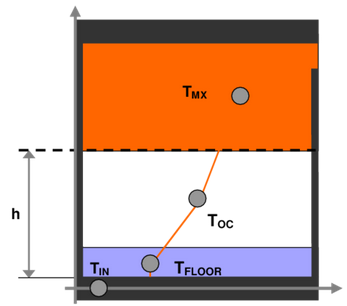
HVAC tab in model data
This model is applicable to spaces that are served by a low velocity floor-level displacement ventilation air distribution system. Furthermore, the dominant sources of heat gain should be from people and other localized sources located in the occupied part of the room. The model should be used with caution in zones which have large heat gains or losses through exterior walls or windows or which have considerable direct solar gain. The model predicts three temperatures in the room:

The following fields are used to define the Three node displacement ventilation room air temperature distribution.
Select the schedule defining the fractions of the convective portion of the internal gains in the occupied subzone that remain in the occupied subzone. The remainder of the convective portion of the internal gains in the occupied subzone enters the plumes and is carried to the upper subzone. The types of internal gains that are assumed to be located in the occupied subzone are:
Types of internal gains that are assumed to be in the upper subzone are:
The schedule values should be between 0 and 1. A value of 1 means that all the convection gains from equipment, task lights and people are dispersed in the lower occupied subzone. Conversely a value of 0 puts all the lower subzone convective gains into the plumes rising into the upper well-mixed subzone.
This field specifies number of plumes per occupant. Plumes are associated with localized sources of convective heat gain from people and equipment. For example, a value of 2.0 would be used if each occupant has a computer that generates a separate plume that does not merge with the plume from the occupant in the lower, occupied, subzone.
This field is the height (in m or ft) of the thermostat/temperature control sensor above the floor.
The height (in m or ft) above the floor at which air temperature is calculated for comfort purposes. The air temperature at this height is used in calculating the available measures of comfort: Fanger, Pierce or KSU. The default is 1.1m.
This field specifies a minimum temperature difference between the upper mixed subzone and the occupied subzone that will be used to trigger whether or not the displacement ventilation auxiliary outputs will be calculated. These outputs are Room Air Zone Transition Height, Room Air Zone Recommended Minimum Flow Fraction, Room Air Zone Average Temperature Gradient and Room Air Zone Maximum Temperature Gradient. They are set to negative values when the temperature difference is less than the threshold and the output Room Air Zone Is Mixed Status is set to 1.
The value should be greater than or equal to zero and is in units of Delta °C or Delta °F. The default value is 0.4°C.